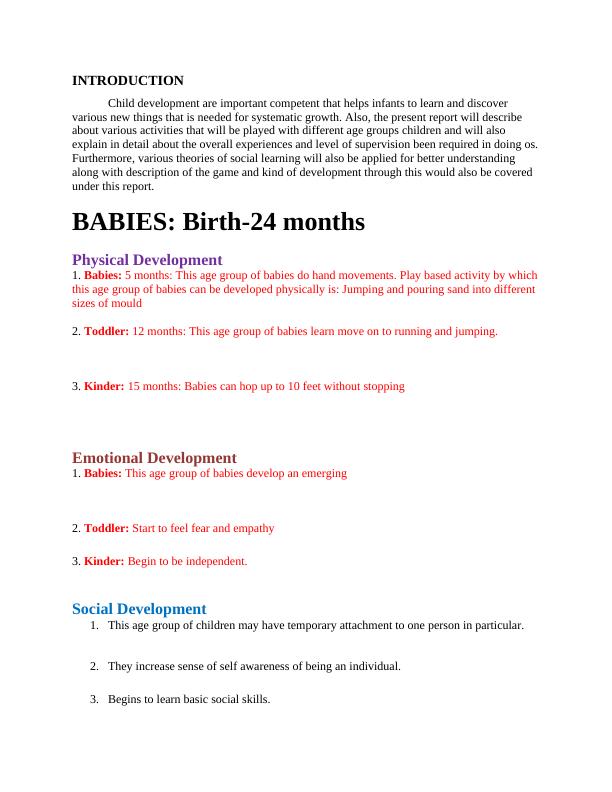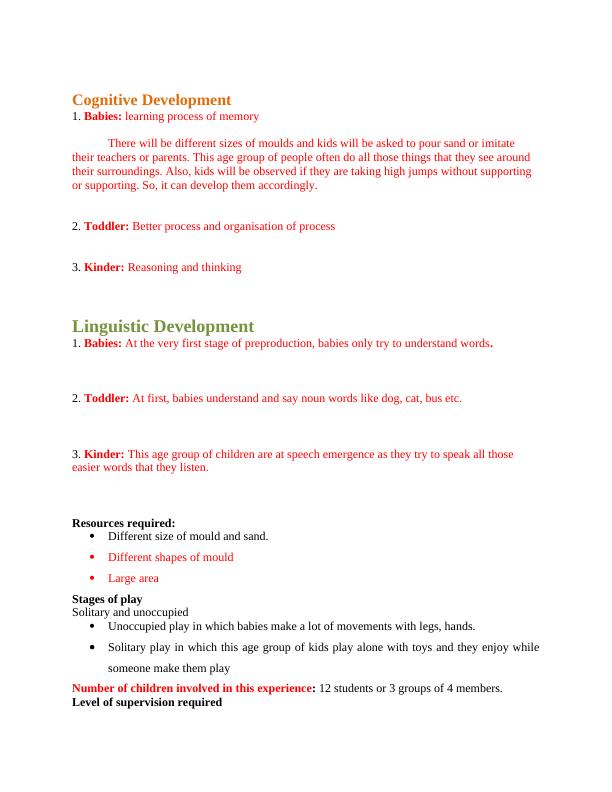Child Development Activities for Different Age Groups
Added on 2023-06-07
13 Pages3256 Words412 Views
INTRODUCTION
Child development are important competent that helps infants to learn and discover
various new things that is needed for systematic growth. Also, the present report will describe
about various activities that will be played with different age groups children and will also
explain in detail about the overall experiences and level of supervision been required in doing os.
Furthermore, various theories of social learning will also be applied for better understanding
along with description of the game and kind of development through this would also be covered
under this report.
BABIES: Birth-24 months
Physical Development
1. Babies: 5 months: This age group of babies do hand movements. Play based activity by which
this age group of babies can be developed physically is: Jumping and pouring sand into different
sizes of mould
2. Toddler: 12 months: This age group of babies learn move on to running and jumping.
3. Kinder: 15 months: Babies can hop up to 10 feet without stopping
Emotional Development
1. Babies: This age group of babies develop an emerging
2. Toddler: Start to feel fear and empathy
3. Kinder: Begin to be independent.
Social Development
1. This age group of children may have temporary attachment to one person in particular.
2. They increase sense of self awareness of being an individual.
3. Begins to learn basic social skills.
Child development are important competent that helps infants to learn and discover
various new things that is needed for systematic growth. Also, the present report will describe
about various activities that will be played with different age groups children and will also
explain in detail about the overall experiences and level of supervision been required in doing os.
Furthermore, various theories of social learning will also be applied for better understanding
along with description of the game and kind of development through this would also be covered
under this report.
BABIES: Birth-24 months
Physical Development
1. Babies: 5 months: This age group of babies do hand movements. Play based activity by which
this age group of babies can be developed physically is: Jumping and pouring sand into different
sizes of mould
2. Toddler: 12 months: This age group of babies learn move on to running and jumping.
3. Kinder: 15 months: Babies can hop up to 10 feet without stopping
Emotional Development
1. Babies: This age group of babies develop an emerging
2. Toddler: Start to feel fear and empathy
3. Kinder: Begin to be independent.
Social Development
1. This age group of children may have temporary attachment to one person in particular.
2. They increase sense of self awareness of being an individual.
3. Begins to learn basic social skills.

Cognitive Development
1. Babies: learning process of memory
There will be different sizes of moulds and kids will be asked to pour sand or imitate
their teachers or parents. This age group of people often do all those things that they see around
their surroundings. Also, kids will be observed if they are taking high jumps without supporting
or supporting. So, it can develop them accordingly.
2. Toddler: Better process and organisation of process
3. Kinder: Reasoning and thinking
Linguistic Development
1. Babies: At the very first stage of preproduction, babies only try to understand words.
2. Toddler: At first, babies understand and say noun words like dog, cat, bus etc.
3. Kinder: This age group of children are at speech emergence as they try to speak all those
easier words that they listen.
Resources required:
Different size of mould and sand.
Different shapes of mould
Large area
Stages of play
Solitary and unoccupied
Unoccupied play in which babies make a lot of movements with legs, hands.
Solitary play in which this age group of kids play alone with toys and they enjoy while
someone make them play
Number of children involved in this experience: 12 students or 3 groups of 4 members.
Level of supervision required
1. Babies: learning process of memory
There will be different sizes of moulds and kids will be asked to pour sand or imitate
their teachers or parents. This age group of people often do all those things that they see around
their surroundings. Also, kids will be observed if they are taking high jumps without supporting
or supporting. So, it can develop them accordingly.
2. Toddler: Better process and organisation of process
3. Kinder: Reasoning and thinking
Linguistic Development
1. Babies: At the very first stage of preproduction, babies only try to understand words.
2. Toddler: At first, babies understand and say noun words like dog, cat, bus etc.
3. Kinder: This age group of children are at speech emergence as they try to speak all those
easier words that they listen.
Resources required:
Different size of mould and sand.
Different shapes of mould
Large area
Stages of play
Solitary and unoccupied
Unoccupied play in which babies make a lot of movements with legs, hands.
Solitary play in which this age group of kids play alone with toys and they enjoy while
someone make them play
Number of children involved in this experience: 12 students or 3 groups of 4 members.
Level of supervision required

0-18 months of kids are at the highest risk of injury as at this stage they learn to walk,
scrawl and stand up. So, there is requirement of constant as well as close supervision
Extension to the activity
Continuous support
Desired shapes of mould will be given
Intentions and learning goal
The main goal of this sensory motor based experience play is to increase cognitive skills
of kids.
To increase their concentration and balance.
Additional support
Symbolic play is one of the best ways by which children of this age group can overcome their
impulsiveness. It can develop their thought out behaviour that will help them out in developing
cognitive functions. In addition, it can be said that it is the first ladder to numeracy and literacy
so, on the basis of this, it can be said that children can learn the way of adapting new things.
EYLF outcomes:
Children will have a sense of belongingness and well-being
Relationships between all areas of Development:
Physical
Through game based activity, children’s fine motor skills can be developed.
Cognitive
This experience based play will allow children to explore concept development and to
experience new choice.
EYLF practices
It is a small group and play based activity.
EYLF principles
Improved and secure relationship
Linkage to theorists:
Vygotsky theory of social learning is associated with this experience and game play.
This theory states that learning is a social process in which children often learn number of things
with the support of their parents, peers, wider society and caregivers (Liaqat and Munteanu,
2019). So, for this reason, by continuous and close support of care givers, this age group of kids
will be allowed to develop their brain functions and motor skills.
Albert Bandura’s social learning theory is also associated with this age group of kids.
This theory states that imitation, observation and modelling of others is important as infants
often learn by observation and imitation. For this reason, this game has been selected. 0-18
months of kids will do what they will observe to their care givers and parents and by doing the
same, it can develop their motor skills and brain functions (KILINÇ, YILDIZ and HARMANCI,
2018).
scrawl and stand up. So, there is requirement of constant as well as close supervision
Extension to the activity
Continuous support
Desired shapes of mould will be given
Intentions and learning goal
The main goal of this sensory motor based experience play is to increase cognitive skills
of kids.
To increase their concentration and balance.
Additional support
Symbolic play is one of the best ways by which children of this age group can overcome their
impulsiveness. It can develop their thought out behaviour that will help them out in developing
cognitive functions. In addition, it can be said that it is the first ladder to numeracy and literacy
so, on the basis of this, it can be said that children can learn the way of adapting new things.
EYLF outcomes:
Children will have a sense of belongingness and well-being
Relationships between all areas of Development:
Physical
Through game based activity, children’s fine motor skills can be developed.
Cognitive
This experience based play will allow children to explore concept development and to
experience new choice.
EYLF practices
It is a small group and play based activity.
EYLF principles
Improved and secure relationship
Linkage to theorists:
Vygotsky theory of social learning is associated with this experience and game play.
This theory states that learning is a social process in which children often learn number of things
with the support of their parents, peers, wider society and caregivers (Liaqat and Munteanu,
2019). So, for this reason, by continuous and close support of care givers, this age group of kids
will be allowed to develop their brain functions and motor skills.
Albert Bandura’s social learning theory is also associated with this age group of kids.
This theory states that imitation, observation and modelling of others is important as infants
often learn by observation and imitation. For this reason, this game has been selected. 0-18
months of kids will do what they will observe to their care givers and parents and by doing the
same, it can develop their motor skills and brain functions (KILINÇ, YILDIZ and HARMANCI,
2018).

Toddlers: 2-3 years’ old
Physical Development
1. Babies: Babies of this age group can use basic words and can walk.
Building sandcastle will be the play based activity by which babies of this age group can be
developed physically, emotionally and socially.
2. Toddler: Toddlers love to play with others.
This would be done through making the children sits in whole groups where through their
knowledge and levels of understanding they would build blocks out of sand and water so that
best castle might be built at the end. So, it can develop them in all manners.
Emotional Development
1. Babies: They afraid of strangers and do not prefer to talk to them.
2. Toddler: Have some tantrums and start to feel separation.
Social Development
1. Establish positive relations with others
2. They have understanding to know as which things
Cognitive Development
1. Babies at this age become more aware as they can use imagination as well as begin to play
pretended games.
Physical Development
1. Babies: Babies of this age group can use basic words and can walk.
Building sandcastle will be the play based activity by which babies of this age group can be
developed physically, emotionally and socially.
2. Toddler: Toddlers love to play with others.
This would be done through making the children sits in whole groups where through their
knowledge and levels of understanding they would build blocks out of sand and water so that
best castle might be built at the end. So, it can develop them in all manners.
Emotional Development
1. Babies: They afraid of strangers and do not prefer to talk to them.
2. Toddler: Have some tantrums and start to feel separation.
Social Development
1. Establish positive relations with others
2. They have understanding to know as which things
Cognitive Development
1. Babies at this age become more aware as they can use imagination as well as begin to play
pretended games.

End of preview
Want to access all the pages? Upload your documents or become a member.
Related Documents
Physical Development Experiences for Children of Different Age Groupslg...
|13
|3094
|120
Analysis of Development Through Children’s Toys.lg...
|6
|1131
|12
Portfolio of Mathematics Projectslg...
|11
|2690
|226
Children Development & Learninglg...
|20
|5109
|66
Teaching Resources and Learning Experiences for Babies and Toddlerslg...
|5
|1770
|318
JANUARY2020 - Early Childhood Learninglg...
|9
|1123
|16